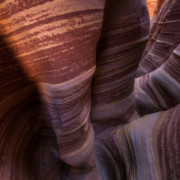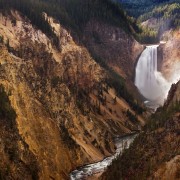Handheld Landscape Photography Tips to capture Stunning Photos
If you’re a landscape photographer, using a tripod is probably integral to your field workflow, and for good reason. A tripod allows you to slow down shutter speed for blurred water effects, make images even in very low light situations, and capture a broad depth of field — all while ensuring your images are sharp and free of camera shake. But there can be times when you do not have a tripod. Perhaps you don’t want to carry the extra weight, or maybe the light is changing fast and there’s no time to set up a tripod. Some locations even restrict the use of tripods. So, what can you do to achieve sharp, beautiful photos handheld? Here are some landscape photography tips that can help.

“Autumn Storm”, Canadian Rockies, October 1, 2017. Handheld. Canon 5DsR with Canon 100-400mm f/4.5-5.6 lens. 164mm, ISO 400, f/10, 1/250 sec.
1. Choose a fast shutter speed
To minimize the effect of camera shake, choose a shutter speed that is fast enough to freeze motion. A good rule of thumb is to choose a shutter speed that is 2x focal length or your lens. So, if your lens has a focal length of 400mm, try not to shoot any slower than 1/800th of a second. Likewise, if your lens has a focal length of 100mm, keep the shutter speed at 1/200th of a second or faster. And, so on.

“Alone in the Woods”, Glacier National Park, October 5, 2017 — Handheld. Canon 5DsR with Canon 100-400mm f/4.5-5.6 lens. 214 mm, ISO 500, f/5.6, 1/400 sec.
2. Select an aperture appropriate for the photography composition
If your subject is far away and the plane of focus is more or less shallow, then you’re in luck. You can use a wider aperture (smaller f-stop number) without needing to bump up the ISO as much. However, if you need to capture a broad depth of field keeping both foreground and background in focus, then you will need to make a decision. Using a smaller aperture, such as f/16 might require slowing down the shutter speed, which increases the risk of camera shake. So, that brings me to tip #3.

“Canadian Rockies Turquoise”, October 1, 2017. Handheld. Sony a7RII with Canon 24-105mm f/4 L lens. 67mm, ISO 100, f/10, 1/250 sec.
3. Increase ISO Setting
Increasing the ISO setting will add noise to your landscape photography, but it may be necessary to maintain a faster shutter speed. Adjust your ISO only after you’ve first decided on shutter speed and aperture. Some camera models tolerate higher ISO settings with less noise than others, so it is important to experiment with your camera and decide how much noise is considered OK for your taste. If noise in your landscape photo is completely unacceptable to you, and you still want to maintain a fast shutter speed, there is one more option.
4. Use Photoshop to overcome challenges
Some issues in the field can be solved with software in post-processing. For example, if you want to keep the ISO down, but you also need maximum depth of field, you can use focus-stacking techniques. Here’s how: Holding the camera steady, make a series of exposures with a wide aperture (smaller number) capturing different focal distances across the entire depth range you want in focus.
Then, open the files as layers into Photoshop from Adobe Lightroom.
Once the files are opened in Photoshop, with all the layers selected, choose “Auto Align Layers” from the “Edit” menu. Photoshop is pretty good at aligning images, even if they are slightly askew from one another.
Then, select “Auto Blend Layers” from the “Edit” menu. Photoshop will automatically create masks to blend the sharpest parts of each layer.
5. Brace your camera
If you find that you must use a slower shutter speed than the recommended 2x lens focal length, then do what you can to brace the camera and practice proper handholding technique. A wall or rail can be enough to steady the camera. Otherwise, assume a solid stance, feet spread, and elbows in close to your body. A lower center of gravity will also steady the camera, so consider sitting on the ground, or better yet, place the camera on the ground.

“English Sheep”, July 16, 2017, England. Handheld. Sony a7RII with Sony 24-240mm f/3.5-6.3 lens. 130mm, ISO 3200, f/10, 1/500 sec.
6. Use your camera’s burst mode
When you depress the shutter release to make an exposure, it is likely that the camera will move very slightly, causing blurring. By setting your camera to burst mode, the first frame may have some evidence of camera shake, but subsequent images may be sharper.

“Autumn Pallet”, October 5, 2017, Glacier National Park. Handheld. Canon 5DsR with Canon 100-400mm f/4.5-5.6 lens. 400mm, ISO 640, f/7.1, 1/640 sec.
Burst mode will not always produce sharp photos, but it does increase your chances of getting a sharp landscape photo.
7. Turn on image stabilization
If your camera or lens is equipped with image stabilization technology, make sure it is turned on. Consult your camera manual to learn more about how to enable image stabilization. This is contrary advice to what you should do if your camera is mounted on a tripod, in which case image stabilization can actually cause camera shake, blurring your image.
I don’t advocate leaving a tripod behind for landscape photography, but if you do find yourself in a situation where you don’t have one, these tips can ensure that you have the best chance of getting the photography composition you envisioned.






 Grant Collier
Grant Collier




Step 5, brace the camera…
I find a tripod works well for this, and a monopoly also works, but not as much.
Certainly, a tripod works quite well to brace the camera, as does a monopod (I assume that’s what you meant?). My article was about ways to get sharp photos when you don’t have a tripod with you. Most landscape photographers consider a tripod an integral part of the camera kit. However, sometimes it’s just not possible to use a tripod, so then what do you do in those circumstances? That’s what this article is about. Thanks for the suggestion about using a monopod! It is a good alternative, indeed!